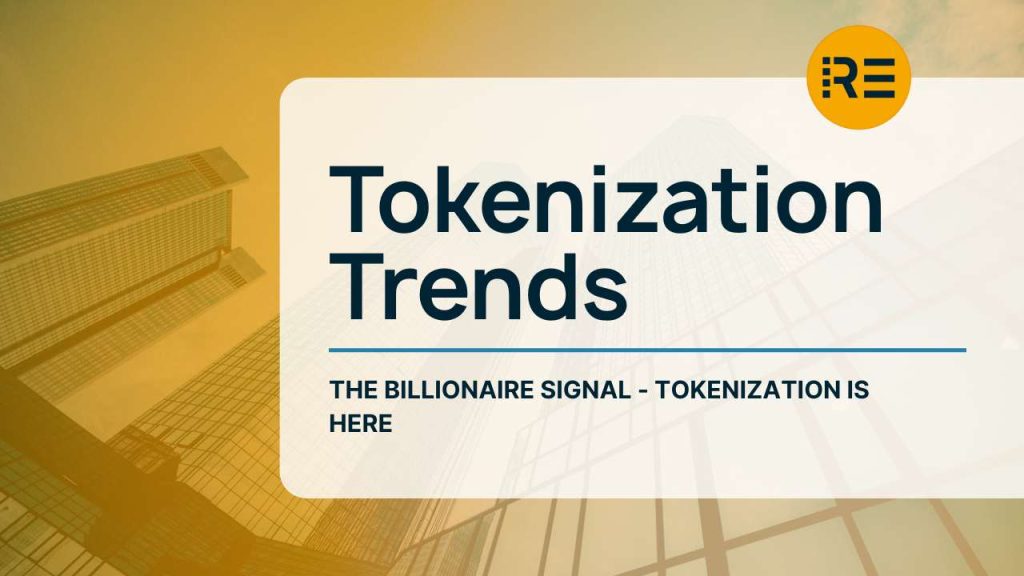Tokenization Trends: A Wake-Up call
October 2025 will be remembered as the month when real estate tokenization moved from “emerging trend” to “institutional inevitability.”
In just 30 days, we witnessed:
- BlackRock’s Bitcoin ETF surpassing $100 billion in assets Cointelegraph BlackRock Sees Tokenization as Next Big Opportunity in Finance
- The world’s largest asset manager announcing proprietary tokenization technology MarketWatch Crypto hype is affecting everything from real estate to Treasurys. Here’s how to play it. – MarketWatch
- Major financial media outlets dedicating coverage to the crypto-real estate convergence Yahoo! Finance Former TD Ameritrade Chair Predicts All Assets Will Be Tokenized Within Five Years
- Big Four consulting firms publishing institutional-grade research forecasting a $4 trillion tokenized real estate market Deloitte Tokenized real estate | Deloitte Insights
For real estate syndicators, this isn’t just news—it’s a wake-up call.
This roundup breaks down the four most significant developments from October 2025 and, more importantly, what they mean for your syndication business going forward.
- BlackRock Goes All-In: “We’re Just at the Beginning”
A Big Announcement from the Biggest (Source: Cointelegraph BlackRock Sees Tokenization as Next Big Opportunity in Finance)
On October 14-15, 2025, BlackRock CEO Larry Fink made headlines across financial media with a series of announcements that fundamentally changed the tokenization conversation.
Speaking on CNBC’s Squawk Box, Fink declared: “I do believe we’re just at the beginning of the tokenization of all assets, from real estate to equities, to bonds—across the board. We look at that as the next wave of opportunity for BlackRock over the next tens of years.”
Read the full article: BlackRock Sees Tokenization As Next Big Opportunity in Finance (Cointelegraph)
The Numbers Behind the Commitment
This wasn’t empty rhetoric. Fink backed his vision with concrete milestones:
- $100 billion: BlackRock’s spot Bitcoin ETF (IBIT) assets—achieved in just 21 months, making it the firm’s most profitable fund
- $104 billion: Total crypto assets under management (1% of BlackRock’s $13.5 trillion AUM)
- $2.8 billion: BlackRock’s BUIDL tokenized money market fund
- $4.5 trillion: Total value in global digital wallets (crypto, stablecoins, and tokenized assets)
Perhaps most significantly, Fink revealed that BlackRock is “spending a great deal of time developing our own technology” for tokenization and digitization of assets, including real estate, stocks, and bonds.
What This Means for Syndicators
Context matters here. This is the same Larry Fink who called Bitcoin an “index of money laundering” in 2017. His complete reversal—backed by billions in committed capital—sends an unmistakable signal to the market.
When the world’s largest asset manager pivots this aggressively, three things happen:
- Institutional capital follows. BlackRock’s $10 trillion client base is watching and will allocate accordingly.
- Regulatory clarity accelerates. Major financial institutions demand (and receive) clear regulatory frameworks.
- Industry standards emerge. BlackRock’s infrastructure choices will define best practices.
For real estate syndicators, the implication is clear: The infrastructure that BlackRock is building won’t just serve their funds—it will set the standard that your future LPs expect from ALL real estate investments.
REtokens Take:
BlackRock’s announcement represents validation at the highest level. But validation isn’t adoption—and that’s where the opportunity exists for forward-thinking syndicators.
While BlackRock builds institutional-grade infrastructure over the next several years, early-moving syndicators can capture market share NOW by partnering with existing compliant tokenization platforms.
The question isn’t whether your LPs will eventually expect tokenized offerings. The question is whether you’ll be the first syndicator they know who offers them—or the last one scrambling to catch up.
- MarketWatch: The Crypto-Real Estate Convergence Is Here
When Mainstream Media Connects the Dots (Source: MarketWatch Crypto hype is affecting everything from real estate to Treasurys. Here’s how to play it. – MarketWatch)
MarketWatch published an analysis that many real estate professionals missed—but shouldn’t have: “Crypto hype is affecting everything from real estate to Treasurys—here’s how to play it.”
Read the full article: Crypto hype is affecting everything from real estate to Treasurys—here’s how to play it (MarketWatch)
The Convergence Thesis
MarketWatch’s analysis highlights a critical shift: The line between traditional real estate investment and crypto/digital assets is disappearing.
Here’s what’s driving the convergence:
On the crypto side:
- $4.5 trillion sitting in digital wallets globally
- Investors seeking yield and real-world asset exposure
- Infrastructure mature enough to handle institutional volume
- Regulatory frameworks providing clarity
On the real estate side:
- Persistent liquidity challenges in private markets
- Investor demand for fractional ownership
- Technology enabling 24/7 global trading
- Tokenization solving structural inefficiencies
The result: A new asset class that combines real estate’s stability with crypto’s liquidity infrastructure.
How Investors Are “Playing It”
MarketWatch outlines several strategies investors are using to capitalize on this convergence:
- Direct tokenized real estate exposure through platforms offering fractional ownership
- Hybrid allocations combining traditional real estate with tokenized alternatives
- Infrastructure plays investing in platforms and technology enabling tokenization
- Yield strategies leveraging tokenized real estate for DeFi applications
What This Means for Syndicators
Mainstream financial media coverage signals a tipping point. When MarketWatch dedicates editorial space to explaining crypto-real estate convergence to its retail investor audience, it means:
- Your potential LPs are reading about tokenization
- They’re learning about fractional ownership and 24/7 trading
- They’re comparing traditional syndications to tokenized alternatives
- They’re wondering why YOUR offerings don’t include digital access
REtokens Take:
The convergence MarketWatch describes isn’t theoretical—it’s happening in real-time. But here’s what the article doesn’t fully address: the competitive advantage available to syndicators who move first.
Traditional syndications compete primarily on:
- Deal quality and sponsor reputation
- Projected returns and track record
- Terms and fee structures
- Geographic market and asset class
Tokenized syndications compete on ALL of the above, PLUS:
- Investor liquidity through secondary markets
- Lower minimum investments via fractional ownership
- Global 24/7 capital raising capability
- Automated compliance and distribution
The syndicators who recognize this aren’t just early adopters—they’re redefining what “competitive” means in private real estate fundraising.
- The TD Ameritrade Perspective: History Repeating Itself (Source: Yahoo! Finance Former TD Ameritrade Chair Predicts All Assets Will Be Tokenized Within Five Years)
A Prediction From Someone Who Built the Last Revolution
Yahoo Finance recently published insights from the former chairman of TD Ameritrade—and his predictions should resonate deeply with anyone who remembers how online brokerages transformed stock trading in the 1990s.
Read the full article: Former TD Ameritrade Chair Predicts Major Shift in Financial Assets (Yahoo Finance)
The Parallel Everyone Should See
TD Ameritrade didn’t invent stock trading—they made it accessible, digital, and efficient. They understood something traditional brokers didn’t: technology would fundamentally change who could invest and how they would do it.
Sound familiar?
Consider the parallels:
1990s Online Brokerage Revolution:
- Traditional brokers: “Investors need human intermediaries”
- Technology: “Digital platforms can execute trades efficiently”
- Outcome: Online brokerages captured market share; traditional firms forced to adapt
- Result: Entire industry transformed in less than a decade
2025 Real Estate Tokenization Revolution:
- Traditional syndicators: “LPs need traditional structures”
- Technology: “Blockchain platforms can tokenize ownership efficiently”
- Outcome: TBD—but the trajectory is eerily similar
- Projection: Significant transformation by 2030
Why His Voice Matters
This isn’t a crypto enthusiast making predictions. This is someone who:
- Built a company that fundamentally disrupted financial services
- Watched traditional firms struggle to adapt to digital infrastructure
- Understands how regulatory frameworks evolve with technology
- Recognizes the patterns that signal industry transformation
His prediction? Traditional financial assets—including real estate—are moving to blockchain infrastructure faster than most market participants realize.
What This Means for Syndicators
The former TD Ameritrade chairman’s perspective offers a critical lesson: disruption doesn’t announce itself with trumpets—it arrives gradually, then suddenly.
Online brokerages didn’t replace stock trading overnight. But within a decade:
- Traditional brokerage market share collapsed
- Fee structures compressed by 90%+
- Retail investor participation exploded
- The firms that adapted early dominated; those that waited suffered
Real estate tokenization is following the exact same pattern.
REtokens Take:
The most dangerous assumption in business is: “Our industry is different.”
Traditional stockbrokers in 1995 believed their personal relationships and expertise would protect them from digital disruption. Many were right—until they weren’t.
Real estate syndicators today have the same choice those brokers had:
Option A: Recognize the pattern, adapt early, and build competitive advantage Option B: Wait for “proof,” react late, and fight for market share from a position of weakness
The difference? You have something those brokers didn’t: a clear view of how this story ends. You can see the TD Ameritrade case study. You can see the Blockbuster-Netflix dynamic. You can see the Kodak-digital camera story.
You don’t have the excuse of ignorance. You only have the choice of action or inaction.
- Deloitte’s Institutional Analysis: $4 Trillion by 2035 (Source: Deloitte Tokenized real estate | Deloitte Insights)
When Big Four Firms Publish Research, Markets Listen
In June 2025, Deloitte’s Center for Financial Services published what may be the most comprehensive institutional analysis of tokenized real estate to date: “Digital dividends: How tokenized real estate could revolutionize asset management.”
Read the full report: Tokenized Real Estate | Deloitte Insights (Deloitte)
The $4 Trillion Forecast (And Why It Matters)
Deloitte’s projection isn’t just about a big number—it’s about market structure and opportunity segmentation.
The Breakdown:
$1 Trillion: Tokenized Private Real Estate Funds
- Market penetration: 8.5%
- This is YOUR segment, syndicators
- Includes tokenized LP interests, automated servicing, secondary trading
- Primary use case: Funds raising capital for specific deals
$2.39 Trillion: Tokenized Loans & Securitizations
- Market penetration: 0.55%
- Debt instruments on blockchain
- Examples: Tokenized mortgages, real estate-backed debt
- Lower penetration due to regulatory complexity
$50 Billion: Undeveloped Land & Under-Construction Projects
- Market penetration: 0.80%
- Pre-completion project financing
- Higher risk profile limiting adoption
Total Growth: $300 billion (2024) → $4 trillion (2035) = 27% compound annual growth rate
Why Deloitte’s Analysis Carries Weight
This isn’t a startup white paper or crypto blog post. Deloitte’s research represents:
- Institutional validation: Big Four firms advise the world’s largest financial institutions
- Rigorous methodology: 40+ pages of data-driven analysis, case studies, and projections
- Client demand signals: Deloitte publishes research because their clients are asking for it
- Investment implications: This research informs billions in capital allocation decisions
When Deloitte tells institutional investors that tokenized real estate will reach $4 trillion, those investors begin allocating capital accordingly.
Key Findings for Syndicators
Deloitte’s research highlights several critical insights:
On Infrastructure:
“Single and interconnected blockchain-based platforms can offer convenient and swift ways to handle the issuance of tokenized limited partners’ equity interest, asset servicing, and secondary market trading.”
Translation: The technology exists TODAY to automate everything you currently do manually.
On Regulatory Environment:
“Regulatory frameworks are being established to govern the issuance and operation of digital assets, stablecoins, permissionless blockchains, and distributed ledger technologies. These developments suggest a shift toward a more permissive regulatory environment.”
Translation: The regulatory uncertainty excuse is fading fast.
On Market Structure:
“Tokenization allows fractional ownership of high-value properties, democratizing real estate investment and enabling smaller investors to access previously unreachable markets.”
Translation: Your competition can now access LP capital you’ve never been able to reach.
What This Means for Syndicators
Deloitte’s analysis reveals the most important insight for syndicators: Private real estate funds represent the LARGEST tokenization opportunity—8.5% market penetration by 2035.
That’s a $1 trillion addressable market in YOUR segment.
But here’s the critical question: Will YOUR syndications be part of that 8.5%, or part of the 91.5% still operating traditionally?
Consider the math:
- If 8.5% of private funds are tokenized by 2035…
- And tokenized funds capture investor preference due to liquidity advantages…
- Then non-tokenized funds are competing for a shrinking pool of capital willing to accept illiquidity
This isn’t just about being early. It’s about survival in an increasingly competitive capital formation environment.
REtokens Take:
Deloitte’s research does something crucial: It removes tokenization from the “speculative” category and places it firmly in the “strategic planning” category.
When institutional advisors publish research like this, theoretically it could trigger a cascade such as this:
- Year 1-2 (2025-2026): Advisory firms educate clients on tokenization opportunities
- Year 2-4 (2026-2028): Institutional investors begin allocation strategies
- Year 4-6 (2028-2030): Capital flows materially toward tokenized offerings
- Year 6-10 (2030-2035): Market structure fundamentally transformed
Here’s what most syndicators miss: By the time Step 3 happens (material capital flows), the window for positioning as a market leader has closed.
The syndicators building tokenization capabilities NOW will be the ones capturing institutional allocations in 2028-2030. The syndicators waiting for “proof” will be competing for scraps.
Deloitte just handed you the playbook. The only question is whether you’ll or your competitor will use it.
Learn more about tokenization: HERE





